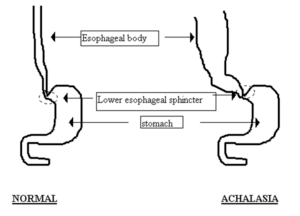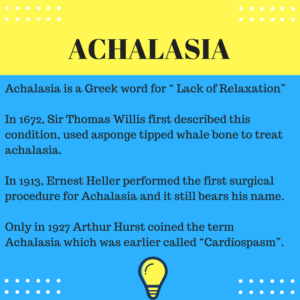By Surgical Gastroenterologist Dr.S.Srivatsan
In this issue of Gut Speak, we shall discuss about another very common GI ailment, Achalasia. As is the trend in Gut speak column, we begin with a case scenario and then proceed towards the management of this condition. Readers are most welcome to address their queries and send feedback about this column to info@padhamhealthnews.org
Mrs. S 30 year old female presented with complaints of difficulty in swallowing, chest pain, regurgitation of food and weight loss over the last 3 months. She was investigated for the above symptoms, underwent an Upper GI endoscopy and Barium Swallow study, was diagnosed with an ailment called “Achalasia Cardia” and was advised to undergo a Manometry test. Surprised by the diagnosis, she had a few questions to ask her gastroenterologist and here is the text of the same.
What exactly does this term Achalasia mean?
The term Achalasia actually means failure to relax. In this condition the Esophageal muscle lacks the ability to move food into the stomach. It is a motility disorder of the food pipe where the LES (a ring of muscle fibres present at the junction between esophagus and stomach) fails to relax or open in response to food in the esophagus. This causes difficulty in swallowing, regurgitation of food and chest pain. In this condition there is an incomplete LES relaxation, increased LES tone, and lack of peristalsis of the esophagus (inability of smooth muscle to move food down the esophagus).
What causes this condition?
Achalasia is of two types- Primary or Idiopathic where there is no obvious cause and Secondary- it occurs secondary to an underlying malignancy or Chagas disease (an infectious disease common in South America). Primary Achalasia is more common where there is an abnormality in the intrinsic nerve fibres of the muscles in the food pipe. This abnormality increases the LES tone, prevents it from opening or relaxing in response to food in the oesophagus, and also affects the inherent peristalsis (the process of propulsion of food) of the food pipe.
Also read: All about the basics of GERD
How common is this ailment?
Achalasia cardia is not a very common disorder. It affects 1 in 100000 persons per year. It is common in both males and females and mainly manifests between 25-40 years.
How will I know if I have Achalasia?
The main symptoms of achalasia are dysphagia (difficulty in swallowing), regurgitation of undigested food, chest pain behind the sternum, and weight loss. Dysphagia tends to become progressively worse over time and involves both fluids and solids. Some people may also experience coughing when lying in a horizontal position. The chest pain experienced, also known as cardiospasm and non-cardiac chest pain can often be mistaken for a heart attack. It can be extremely painful in some sufferers. Food and liquid, including saliva, are retained in the esophagus and may be inhaled into the lungs (aspiration) causing lung infection (Aspiration Pneumonia).

What are the tests done to evaluate this condition?
An Upper GI endoscopy, Chest X ray, Barium Swallow tests may be done to diagnose this condition. However, a Manometry test is needed to confirm the diagnosis.
What is a Barium Swallow test?
The patient swallows a barium solution, with continuous fluoroscopy (X-ray recording) to observe the flow of the fluid through the esophagus. Normal peristaltic movement of the esophagus is not seen. There is acute narrowing at the lower esophageal sphincter and the gastro-esophageal junction, producing a “bird’s beak” appearance. The esophagus above the narrowing is often dilated (enlarged) to varying degrees as the esophagus is gradually stretched over time.
What is a Manometry Test?
Manometry is considered the “gold standard” test for the diagnosis of achalasia. A thin tube is inserted through the nose, and the patient is instructed to swallow several times. The probe measures muscle contractions in different parts of the esophagus during the act of swallowing. Manometry reveals the failure of the LES to relax with swallowing and lack of functional peristalsis (the act of propulsion of food) in the smooth muscle esophagus.
What are the lifestyle modifications one should take when diagnosed with Achalasia?
Both before and after treatment, achalasia patients may need to eat slowly, chew very well, drink plenty of water with meals, and avoid eating near bedtime. Raising the head of the bed or sleeping with a wedge pillow promotes emptying of the esophagus by gravity. After surgery or pneumatic balloon dilatation, proton pump inhibitor tablets are required to prevent reflux damage by inhibiting gastric acid secretion, and foods that can aggravate reflux, including ketchup, citrus, chocolate, alcohol, and caffeine, may need to be avoided.
Are there medications to treat this condition?
Drugs that reduce LES pressure are useful. These include calcium channel blockers such as nifedipine and nitrates such as isosorbide dinitrate and nitroglycerin. However, many patients experience unpleasant side effects such as headache and swollen feet, and these drugs may not be useful in the long run.
I have read about “Botox Treatment” for this condition. How does it help?
Botulinum toxin (Botox) may be injected into the lower esophageal sphincter to paralyze the muscles holding it shut. As in the case of cosmetic Botox, the effect is only temporary and lasts for about 6 months. Botox injections cause scarring in the sphincter which may increase the difficulty of surgery later. This therapy is recommended only for selected patients who cannot risk surgery, such as elderly persons in poor health.
Do you have an endoscopic option to treat this condition?
Yes, you can undergo a Balloon dilatation or Pneumatic dilatation where the abnormal and tight muscle fibers are stretched and slightly torn by forceful inflation of a balloon placed inside the lower esophageal sphincter. However this procedure might require repeated sessions and there is a small risk of perforation of the esophagus with this procedure. It also causes scarring of the tissues and increases the difficulty of surgery, if done later.
What surgery can be done to treat Achalasia?
Surgery for Achalasia is called “Heller’s Myotomy”. It can be done laparoscopically with no scars and requires a very short hospital stay of about 3 days. Heller myotomy helps 90% of achalasia patients. The myotomy is a lengthwise cut along the esophagus, starting above the LES and extending down onto the stomach. The esophagus is made of several layers, and the myotomy cuts only through the outside muscle layers which are squeezing it shut, leaving the inner muscosal layer intact. A partial fundoplication or “wrap” is generally added in order to prevent excessive reflux, which can cause serious damage to the esophagus over time. After surgery, patients should be kept on a soft diet for several weeks to a month, avoiding foods that can aggravate reflux.
What are the complications of long standing Achalasia?
Untreated achalasia may lead to nocturnal inhalation of material lodged in the oesophagus and lung infection, Aspiration pneumonia. In long standing untreated achalasia there is a 2- 7% risk of Cancer Esophagus. Presumably, potential carcinogens (cancer causing irritants) are held in the esophagus instead of being moved along, due to an abnormality in the LES tone.
Also read: Things to keep in mind before electing for a surgery

